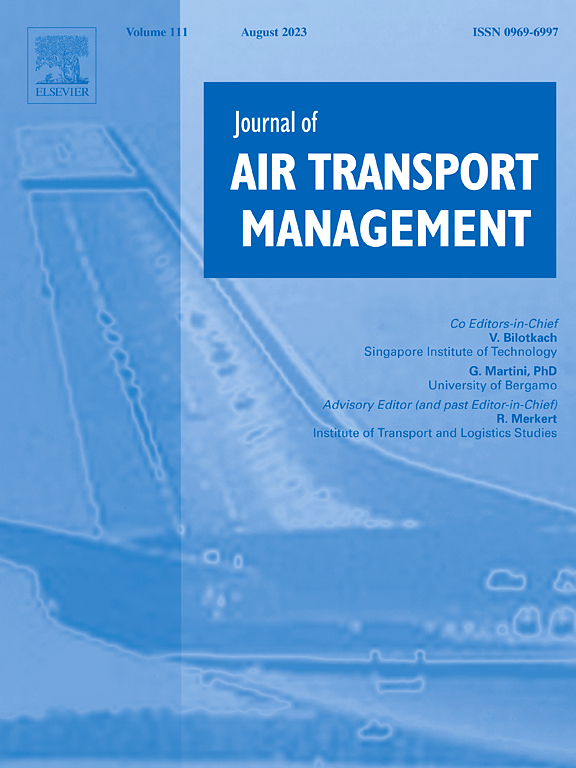Air traffic control method for more fuel efficient arrivals in terminal airspace
IF 3.6
2区 工程技术
Q2 TRANSPORTATION
引用次数: 0
Abstract
Growing air traffic demand in recent years means that the aviation industry is faced with challenges in rising CO2 emissions, associated fuel costs, congestion, noise and operational complexity. Approach and sequencing in terminal airspace is one such phase of flight, at which congestion has high cost in fuel and management of operational complexity. A novel solution for mitigating these negative impacts in a simple and cost-effective manner are welcome. The present study evaluated the efficacy of air traffic control operations combining fixed-flight path angle descent and speed control techniques, on fuel efficiency and pilot operability. We designed a series of flight scenarios for Kansai International Airport arrivals and ran them in a simulation environment. The fixed-flight path angle descent facilitates more precise and reliable prediction of arrival trajectory and reduction in air traffic control operation complexity. The fixed-flight path angle descent procedure has additional anticipated benefits, namely, reduction in fuel burn and the ability to control aircraft speed without compromising fuel efficiency. It may therefore be a viable contender for arrival sequencing and separation maintenance tactic, in place of today’s common vectoring technique. Furthermore, the fixed-flight path angle descent can be performed without modifications or additions to the current onboard electronic equipment of aircraft. This paper demonstrates that combination of fixed-flight path angle descent and speed control performed in a commercial aircraft has the same utility in the route extension by vectoring performed by air traffic controllers during congested air traffic and can be performed while achieving reduction in fuel consumption. Flight simulator tests of an aircraft approaching Kansai International Airport from a southwestern or western direction show that combination of fixed-flight path angle descent and speed control can reduce fuel consumption by up to approximately 260 pounds per flight, without causing noticeable problem in the aircraft operation. Furthermore, the relationship between the en-route sector, upstream of the terminal airspace, and the angle selected for the fixed-flight path angle descent, the operational issues for performing the proposed speed control method are discussed.
空中交通管制方法,以提高燃油效率,到达航站楼空域
近年来不断增长的空中交通需求意味着航空业面临着二氧化碳排放量上升、相关燃料成本、拥堵、噪音和运营复杂性等挑战。航站楼空域的进近和排序就是这样一个飞行阶段,在这个阶段,拥堵的燃料成本高,操作管理复杂。一种以简单和经济有效的方式减轻这些负面影响的新颖解决方案受到欢迎。本研究评估了结合固定飞行路径角度下降和速度控制技术的空中交通管制操作在燃油效率和飞行员可操作性方面的有效性。我们为关西国际机场的到达设计了一系列的飞行场景,并在模拟环境中运行。固定航迹角度下降有助于更精确、可靠地预测到达轨迹,降低空管操作复杂性。固定飞行路径角度下降程序有额外的预期好处,即减少燃料消耗和控制飞机速度而不影响燃油效率的能力。因此,它可能是到达序列和分离维护策略的可行竞争者,取代当今常见的矢量技术。此外,固定航迹角度下降可以在不修改或增加现有机载电子设备的情况下进行。本文论证了商用飞机固定航迹角度下降与速度控制的结合,在交通拥挤情况下,对空管进行矢量航路扩展具有相同的效用,并且可以在减少燃油消耗的同时进行。从西南或西向接近关西国际机场的飞机的飞行模拟器测试表明,固定飞行路径角度下降和速度控制相结合,每次飞行可减少约260磅的燃油消耗,而不会引起飞机运行中的明显问题。此外,还讨论了航路扇区、终端空域上游扇区与固定航路角度下降选择的角度之间的关系,以及执行所提出的速度控制方法的操作问题。
本文章由计算机程序翻译,如有差异,请以英文原文为准。
求助全文
约1分钟内获得全文
求助全文
来源期刊

Journal of Air Transport Management
TRANSPORTATION-
CiteScore
12.40
自引率
11.70%
发文量
97
期刊介绍:
The Journal of Air Transport Management (JATM) sets out to address, through high quality research articles and authoritative commentary, the major economic, management and policy issues facing the air transport industry today. It offers practitioners and academics an international and dynamic forum for analysis and discussion of these issues, linking research and practice and stimulating interaction between the two. The refereed papers in the journal cover all the major sectors of the industry (airlines, airports, air traffic management) as well as related areas such as tourism management and logistics. Papers are blind reviewed, normally by two referees, chosen for their specialist knowledge. The journal provides independent, original and rigorous analysis in the areas of: • Policy, regulation and law • Strategy • Operations • Marketing • Economics and finance • Sustainability
 求助内容:
求助内容: 应助结果提醒方式:
应助结果提醒方式:


